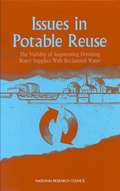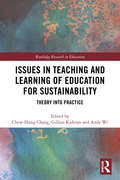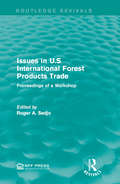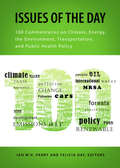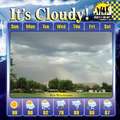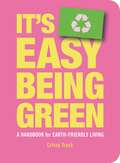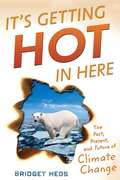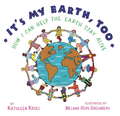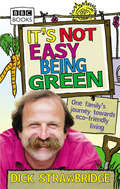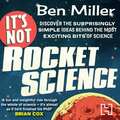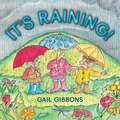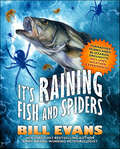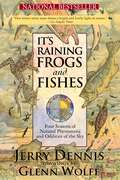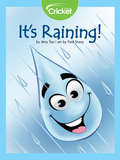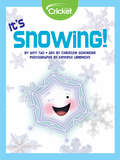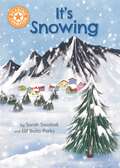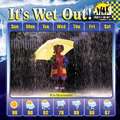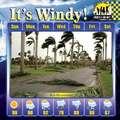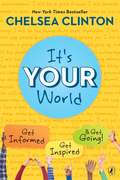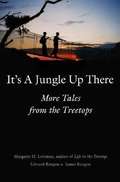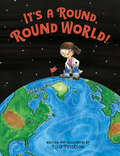- Table View
- List View
Issues and Earth Science: Solar System and Beyond
by University of California at Berkeley Lawrence Hall of ScienceNIMAC-sourced textbook
Issues and Earth Science: Weather and Climate
by University of California at Berkeley Lawrence Hall of ScienceNIMAC-sourced textbook
Issues in Potable Reuse: The Viability of Augmenting Drinking Water Supplies With Reclaimed Water
by Committee to Evaluate the Viability of Augmenting Potable Water Supplies Reclaimed WaterA small but growing number of municipalities are augmenting their drinking water supplies with highly treated wastewater. But some professionals in the field argue that only the purest sources should be used for drinking water.Is potable reuse a viable application of reclaimed water? How can individual communities effectively evaluate potable reuse programs? How certain must "certain" be when it comes to drinking water safety? Issues in Potable Reuse provides the best available answers to these questions.Useful to scientists yet accessible to concerned lay readers, this book defines important terms in the debate and provides data, analysis, and examples of the experience of municipalities from San Diego to Tampa. The committee explores in detail the two major types of contaminants:Chemical contaminants. The committee discusses how to assess toxicity, reduce the input of contaminants, evaluate treatment options, manage the byproducts of disinfection and other issues.Microbial contaminants, including newly emerging waterborne pathogens. The book covers methods of detection, health consequences, treatment, and more.Issues in Potable Reuse reviews the results of six health effects studies at operational or proposed reuse projects. The committee discusses the utility of fish versus mammals in toxicology testing and covers issues in quality assurance.
Issues in Teaching and Learning of Education for Sustainability: Theory into Practice (Routledge Research in Education)
by Gillian Kidman Chang Chew Hung Andy WiIn a fast-changing, globalising world, the teaching and implementation of a curriculum for Education for Sustainability (EfS) has been a challenge for many teachers. Issues in Teaching and Learning of Education for Sustainability highlights the issues and challenges educators and academics face in implementing EfS and gives examples of what an EfS curriculum may look like and how some institutions translate the theory into practice. Organised into three parts, the volume looks at: the who (EfS for whom), the what (EfS curriculum) and the how (translating from theory to practice). The concluding chapter provides ideas and directions on where the world can proceed regarding sustainability education and how it can help in the teaching and learning of sustainability. Considering social issues such as poverty, education, health, culture and the use of natural resources, this book proposes a different path towards Education for Sustainability. Providing concrete data on the realisation of sustainable development, Issues in Teaching and Learning of Education for Sustainability will be of interest to geographers, geography educators and professionals concerned with Education for Sustainability.
Issues in U.S International Forest Products Trade: Proceedings of a Workshop (Routledge Revivals)
by Roger A. SedjoAfter World War two, the United States became integrates into the world forest economy however the complexity of their trade agreements introduced several issues which needed to be addressed by world forestry policy. Originally published in 1981, this study delves into important issues related to forest resources and trade such as the future role of the United States in the world forest economy, trade restriction and U.S log exports. This title will be of interest to students of Environmental Studies and Economics.
Issues of the Day: 100 Commentaries on Climate, Energy, the Environment, Transportation, and Public Health Policy (RFF Report)
by Felicia Day Ian W.H. ParryIssues of the Day provides an easy way for students, academics, journalists, policymakers, and the public to learn about a diverse range of policy issues affecting the environment, energy, transportation, and public health. Each commentary gives a short assessment of a topic, summarizing in a non-technical way the current state of analysis or evidence on the issue, along with selected recommendations for further reading. The essays are written by world renowned scholars, mostly economists, and provide useful insights on policy problems that are often complex and poorly understood. Some of the topics covered include air pollution, hazardous waste, voluntary environmental programs, domestic (U.S.) and global climate policy design, fishery management, water quality, endangered species, forest fires, oil security, solar power, road and airport, fuel taxes and fuel economy standards, alternative fuel vehicles, health and longevity, smoking, malaria, tuberculosis, and the environment and development. The objective is to disseminate the findings of sound, objective research on the costs, benefits, and appropriate reform of public policies. The book provides a useful supplement for undergraduate- and graduate-level course reading, a reference guide for professionals, and a way for the general reader to quickly develop an informed perspective on the most important policy problems of the day. Issues of the Day is available to download as a PDF from the Resources for the Future website: www.rff.org/weeklycommentary
It's All Connected: A Comprehensive Guide to Global Issus and Sustainable Solutions Facing the Future
by Benjamin Wheeler Gilda Wheeler Wendy ChurchIt's All Connected provides a thorough overview of a full range of global issues, as well as in-depth explorations of particular-topics, debates, and solutions. Each unit contains thematically related chapters. Unit 1 includes an introduction to global issues and sustainability as well as definitions for some important concepts. Units 2-6 address specific global issues, such as food, water, forests, oceans, poverty, culture, education, health, and conflict. The book concludes with a final unit on ideas and tools for addressing global issues, including a curriculum activity for students to study a particular global issue or region. Units can be read separately, sequentially, or in any order to fit particular curriculum needs.
It's Cloudy!
by Kris HirschmannCHECKERBOARD SCIENCE LIBRARY WHAT'S IT LIKE OUT? Is tomorrow a snow day? Will rain delay your baseball game? Does that green sky mean a tornado is on its way? Are you wondering What's It Like Out? In this exciting series, discover how clouds and snowflakes form, why flash floods are dangerous, and how funnel clouds become tornadoes. Find out how forecasters predict what's coming next. Learn all about the science of weather so you can answer the question, What's It Like Out?
It's Easy Being Green: A Handbook for Earth-Friendly Living
by Crissy TraskSurveys find that over 80 percent of Americans agree with the goals of the environmental movement. Sadly, most Americans admit to doing little more than basic recycling when it comes to acting on that disposition. What is the reason for this great divide between environmental sentiment in this country and individual actions? Author and environmental consultant Crissy Trask seeks to answer this question--and solve the disparity--with a new book that makes it easy to be an environmentalist, no matter how busy or hectic your lifestyle. This is a day to day guide with simple, practical suggestions that anyone can put into action.
It's Getting Hot in Here: The Past, Present, and Future of Climate Change
by Bridget HeosTackling the issue of global warming head-on for a teen audience, Bridget Heos examines the science behind it, the history of climate change on our planet, and the ways in which humans have affected the current crisis we face. It's Getting Hot in Here illustrates how interconnected we are not just with everyone else on the planet, but with the people who came before us and the ones who will inherit the planet after us. This eye-opening approach to one of today's most pressing issues focuses on the past human influences, the current state of affairs, the grim picture for the future--and how young readers can help to make a positive change.
It's My Earth, Too
by Kathleen KrullIt's never too early to begin learning about the beauty and bounty of Planet Earth. And now with this bright and rhythmic tribute, young children will find out all the ways in which they, too, can help care for our planet.
It's Not Easy Being Green: One Family's Journey Towards Eco-friendly Living
by Dick StrawbridgeIt's Not Easy Being Green follows Dick Strawbridge and his family as they leave their comfortable home in the Midlands to tackle a remarkable self-sufficiency project - New House Farm in Cornwall. Their main objective is to have as little negative impact on the planet as possible by producing no waste and removing their dependency upon fossil fuels - all without compromising on their comfortable, modern 21st-century lifestyles. It's a laudable aim, but they are definitely not eco-warriors!With his hands-on, flamboyant approach, Dick offers practical tips on everything, from constructing water wheels, gadgets and greenhouses, to the trials of living with animals and knocking up 'proper' wholesome food. Packed with information about the cost of power, sourcing building materials, taking up permaculture and finding transport alternatives, It's Not Easy Being Green highlights the small steps that can change your life and is a simple, inspirational guide for everyone considering the path to green living.
It's Not Rocket Science
by Ben MillerThe Top Ten BestsellerBlack holes. DNA. The Large Hadron Collider. Ever had that sneaking feeling that you are missing out on some truly spectacular science? You do? Well, fear not, for help is at hand. Ben Miller was working on his Physics PhD at Cambridge when he accidentally became a comedian. But first love runs deep, and he has returned to his roots to share with you all his favourite bits of science. This is the stuff you really need to know, not only because it matters but because it will quite simply amaze and delight you. 'Let me show you another, perhaps less familiar side of Science; her beauty, her seductiveness and her passion. And let's do it quickly, while Maths isn't looking' - Ben Miller 'This book makes climate change actually seem interesting. Not just important - it's obviously important - but interesting. As a result I bought lots of other books about climate change, something I now regret'- David MitchellBen Miller is, like you, a mutant ape living through an Ice Age on a ball of molten iron, orbiting a supermassive black hole. He is also an actor, comedian and approximately one half of Armstrong & Miller. He's presented a BBC Horizon documentary on temperature and a Radio 4 series about the history of particle physics, and has written a science column for The Times. He is slowly coming to terms with the idea that he may never be an astronaut.
It's Not Rocket Science
by Ben MillerThe Top Ten BestsellerBlack holes. DNA. The Large Hadron Collider. Ever had that sneaking feeling that you are missing out on some truly spectacular science? You do? Well, fear not, for help is at hand.Ben Miller was working on his Physics PhD at Cambridge when he accidentally became a comedian. But first love runs deep, and he has returned to his roots to share with you all his favourite bits of science. This is the stuff you really need to know, not only because it matters but because it will quite simply amaze and delight you.'Let me show you another, perhaps less familiar side of Science; her beauty, her seductiveness and her passion. And let's do it quickly, while Maths isn't looking' - Ben Miller'This book makes climate change actually seem interesting. Not just important - it's obviously important - but interesting. As a result I bought lots of other books about climate change, something I now regret'- David MitchellBen Miller is, like you, a mutant ape living through an Ice Age on a ball of molten iron, orbiting a supermassive black hole. He is also an actor, comedian and approximately one half of Armstrong & Miller. He's presented a BBC Horizon documentary on temperature and a Radio 4 series about the history of particle physics, and has written a science column for The Times.He is slowly coming to terms with the idea that he may never be an astronaut.
It's Raining (Live Oak Media Ereadalong Series)
by Gail GibbonsGail Gibbons puts her signature style to work as she looks at rain from a child's perspective: What is rain? Why is it necessary? Where does it come from? <P><P>She takes the reader through different components of a storm, from the smallest raindrop to the loudest claps of thunder, and includes tips on how to stay safe and dry. <P><P>With clear facts, simple definitions, and fascinating details, Gibbons's exploration of rain is the perfect choice for curious young readers.
It's Raining Fish and Spiders
by Bill EvansOne of the things Bill Evans enjoys the most is talking to young people about weather. Middle-schoolers in particular, Evans says, are deeply interested in the natural world and in weather. It's Raining Fish and Spiders covers everything, from tornadoes and hurricanes to lightning and the different kinds of snowflakes. Evans addresses weather myths and facts, from "Can it really rain fish?" to "Will opening a window save my house during a tornado?" Evans also tells his most exciting personal weather stories: flying with the Hurricane Hunters, riding pell-mell through Tornado Alley with storm chasers, and visiting the coldest place on Earth. The book includes simple weather experiments that can be performed at home without expensive equipment.Extensively researched, fact-filled, and packed with charts, tables, illustrations, and amazing photographs, It's Raining Fish and Spiders is an entertaining and educational addition to the library of anyone interested in weather, science, and the natural world. At the Publisher's request, this title is being sold without Digital Rights Management Software (DRM) applied.
It's Raining Frogs and Fishes: Four Seasons of Natural Phenomena and Oddities of the Sky (The Wonders of Nature)
by Jerry DennisIt's Raining Frogs and Fishes is a generously illustrated inquiry into wonders of the sky: Why is the sky blue? Where do meteors originate? What causes rainbows, mirages, and the colors of the sunset? Why do some birds and insects migrate, and how do they navigate over hundreds or thousands of miles to do it? How have civilizations throughout history viewed the aurora borealis, tornadoes, eclipses, and the bizarre but well documented cases of fish, reptiles, snails, and even snakes that have rained to earth? Author Jerry Dennis and illustrator Glenn Wolff approach such questions with curiosity and wit, and suggest ways to observe first-hand extraordinary weather, astronomical anomalies, and odd and interesting wildlife of the skies.This updated edition of the national bestseller is a spellbinding look into the natural world's most fascinating and baffling phenomena, with illustrated explanations of rainbows, meteors, sunsets, hurricanes, the northern lights, bird and insect flight, and dozens of other curiosities. Subjects are arranged by season, and each is discussed in a concise and entertaining style that blends the most recent scientific findings with historical anecdotes, personal observations, and examples of the lore and superstitions that have always surrounded phenomena of the skies.PRAISE: &“Amusing and illuminating…This writer-artist team shines a bright and lovely light on nature.&” —Los Angeles Times&“Charming, informative, humorous, and scholarly… embraces wind and weather, the sun, the moon and stars, the seasons of the year and the effect of these things on the denizens of this planet. It is a delight.&” —Nelson Bryant, columnist for The New York Times"Vastly entertaining, valuable... Makes natural history so much fun the reader is sucked from paragraph to paragraph, page to page, chapter to chapter.&” —St. Louis Post-Dispatch"This delightful look at nature...is a cornucopia of fact and lore. Wit, humor, wonder, and reverence spice and season the vignettes herein. It's Raining Frogs and Fishes reminds adults — especially in this hectic, fast-paced, just-do-it world — that it is more than OK, it is desirable, to be child-like and to look up at the heavens and ask why." —Toledo Blade
It's Snowing: Independent Reading Orange 6 Non-fiction (Reading Champion #1154)
by Sarah SnashallThis book is part of Reading Champion, a series carefully linked to book bands to encourage independent reading skills, developed with UCL Institute of Education (IOE)It's Snowing is a non-fiction text reporting on the effects of snow. The simple sentence structure offers readers the opportunity for an independent reading experience with the support of the illustrations.Reading Champion offers independent reading books for children to practise and reinforce their developing reading skills.This early non-fiction text is accompanied by engaging artwork and a reading activity. Each book has been carefully graded so that it can be matched to a child's reading ability, encouraging reading for pleasure.
It's Wet Out!
by Kris HirschmannIntroduces how different types of precipitation form and the dangers and benefits they provide. WHAT'S IT LIKE OUT? Forecasting! Hurricane! It's Cloudy! It's Wet Out! It's Windy! Twister! Is tomorrow a snow day? Will rain delay your baseball game? Does that green sky mean a tornado is on its way? Are you wondering What It's Like Out? In this exciting series, discover how clouds and snowflakes form, why flash floods are dangerous, and how funnel clouds become tornadoes. Find out how forecasters predict what's coming next. Learn all about the science of weather so you can answer the question, What's It Like Out?
It's Windy!
by Kris HirschmannWHAT'S IT LIKE OUT? Forecasting! Hurricane! It's Cloudy! It's Wet Out! It's Windy! Twister! Is tomorrow a snow day? Will rain delay your baseball game? Does that green sky mean a tornado is on its way? Are you wondering What's It Like Out? In this exciting series, discover how clouds and snowflakes form, why flash floods are dangerous, and how funnel clouds become tornadoes. Find out how forecasters predict what's coming next. Learn all about the science of weather so you can answer the question, What's It Like Out?
It's Your World: Get Informed, Get Inspired And Get Going!
by Chelsea ClintonGet Informed! Get Inspired! Get Going!In a book that tackles the biggest challenges facing us today, Chelsea Clinton combines facts, charts, photographs and stories to give readers a deep understanding of the world around them--and how anyone can make a difference. With stories about children and teens who have made real changes big and small--in their families, their communities, in our country and across the world--this book will inspire readers of all ages to do their part to make our world a better place.In addition to informing and inspiring readers about topics including Poverty, Homelessness, Food Insecurity, Access to Education, Gender Equality, Epidemics, Non-Communicable Diseases, Climate Change, and Endangered Species, this book encourages everyone to get going! With suggestions and ideas for action, Chelsea Clinton shows readers that the world belongs to every single one of us, and every one of us counts.You can make a difference. You can make a change. It's your world.From the Hardcover edition.
It's a Jungle Up There: More Tales from the Treetops
by Margaret D. Lowman Edward Burgess James Burgess Ghillean T. PranceDrawn to the mysteries of tropical rain forests and fascinated by life in the treetops, Meg Lowman has pursued a life of scientific exploration while raising her two sons, Edward and James Burgess. This book recounts their family adventures in remote parts of the world (Samoa, West Africa, Peru, Panama, India, Biosphere 2, and others), from the perspectives of both kids and parent. Together they explore tropical rain forests, encounter anacondas and piranhas, eat crickets as hors d'oeuvres, discover new species, and nurture a family ethic for conservation. The chapters of the book focus on field biology questions, the canopy access methods developed to answer the questions, and conservation or education components of each expedition. Lowman enumerates the challenges and joys of juggling parenthood and career, and the children reflect on how their mom's work has affected their lives. A rollicking, inspiring book,It's a Jungle Up There is an upbeat portrayal of how a parent's career can imprint children, and how children in turn can influence the success and trajectory of their parent's career.
It's a Round, Round World! (A Joulia Copernicus Book)
by Ellie PetersonWe all know the earth is round. But HOW do we know? Join intrepid young scientist-adventurer Joulia Copernicus as she takes readers on a historical journey through time and space. From jumping on board Columbus's ship to planet-hopping in the outer reaches of our solar system, Joulia explains with humor and wit the ins and outs of how we learned that the earth is round.

